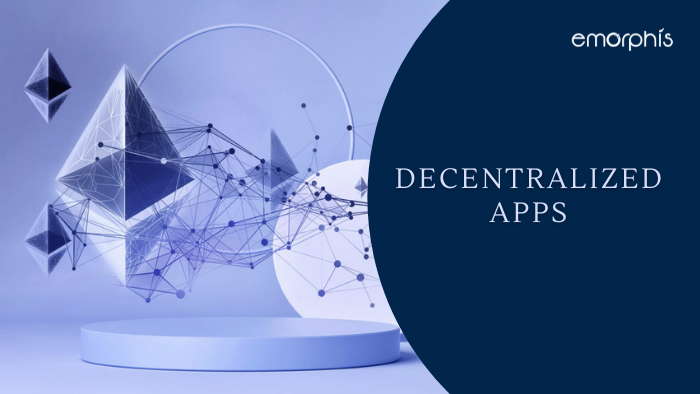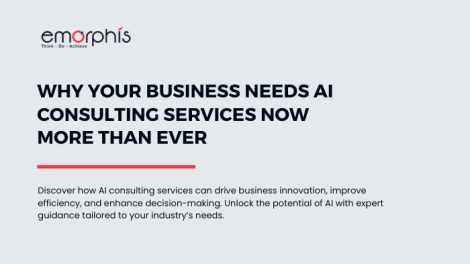Overview
Decentralized app (or Dapp) works on the current exciting technology that is blockchain. The person or organization that focuses on digital business will find decentralized applications the most beneficial app to enhance their fortune. There is no doubt about it.
They bring innovation in software development and also permit users to have full control over data management and platform selection with no interference from a central authority. Now industries such as FinTech are energizing their channel towards building their own Decentralized app. Why?
The major takeaway
They run on multiple platforms (web and mobile apps) at once!
So, the combination of Dapp and FinTech called DeFi (Decentralized Finance) is gaining a lot of momentum in the financial business circle. Why so many companies are showing awareness towards creating DeFi services for their users?
It’s because there is a substantial change in the way of thinking among people about money. They are now focusing on decentralizing financial services (like lending and borrowing) and making them available globally for easing finance, even for the common man.
At present, there are more than thousands of decentralized apps running, and even several FinTech app development companies are using it to use their resources competently. If any FinTech company needs to create its own Decentralized app, it will have to understand certain criteria that will help it to understand its aspects before starting.
So, what will you learn,
In the given article, there will be a major emphasis on finding steps that are crucial to developing Dapp. Moreover, it will evaluate how they help in popularizing FinTech apps further among businessmen.
What is a Decentralized app?
Do you know the main difference between conventional applications and decentralized apps (Dapp)? The former relies on the conventional client-server network, but the latter does not. Moreover, Dapp uses a network of computers (commonly known as nodes)that works independently. They keep a complete record of all the financial transactions and come with several unique features that make FinTech software solutions look more powerful.
The blockchain principle is what defines the features and functioning of decentralized apps in financial industries. The given principle helps in overcoming the problem of duplicity that paves the way for the successful implementation of a viable cryptocurrency. Thus, a widespread blockchain evolution is stamping its victory sign whole over the world.
Benefits of Decentralized App
Why is there a need for the decentralized app? After all, there are a plethora of apps that have the caliber to do each and every work. But some benefits of switching to Dapp will create wonders:
It implies there are no intermediaries so that users can transact with each other directly. It also results in lower pay transaction fees.
2. Users can take part in a decentralized economy
Users can earn financial incentives by working with Dapp and earn tokens that they can exchange at a later period.
3. Better Security and data integrity
Blockchain technology is gaining respect due to the presence of almost no security failures. It is next to impossible for hackers to get easy access to Dapp.
4. No alternative to privacy
Although tracing all transactions in the blockchain is easy, still all are kept anonymous to protect the privacy of the customer’s data.
5. No one can match its uptime
Dapp comes with a smart contract that operates 24/7. It allows it to work flawlessly as long the contract is still live.
6. Eliminating the role of middlemen
The best part of working with Dapp is that it renders the role of middlemen to nothing. With the power of blockchain, there is a direct interaction with customers.
After availing major advantages of the decentralized app, it is time to find out some crucial steps that help in building up a Dapp in the best possible manner.
Five Simple, But VitalSteps to Build a Seamless Dapp Recipe
Developing a perfect decentralized app for the financial sector is not a challenging one but requires proper step-by-step planning. Several procedures help to find out some essential ways to create an innovative and user-friendly DeFi for the customers. To elaborate it well, let’s focus on some of the crucial aspects:
Step 1: Choose Technology that Will Define your Environment Flawlessly
First of all; it is crucial to select one from any of the technology that will help in outlining key areas of development. It comprises the following points:
Database
It includes commonly used databases such as DB2 and Oracle. They are renowned for tight security, high performance, fault tolerance, and effective backup features
Hosting Platforms
Two contenders are Binance Smart Chain (BSC) and Ethereum which can develop and expand any project swiftly
App Frameworks
Several frameworks are there and encompass:
- Truffle: For building pipelines, testing frameworks, and developing environment
- Hardhat: Ethereum development environment exclusively for professionals
- Brownie: Python-based development framework for testing
- Web3j: Platform for developing blockchain apps on JVM
API’s
Dapp uses numerous lists of APIs such as:
- Crypto APIs: They help to unify blockchain and exchanges for better interaction with developers
- Coin API: It is useful for offering quick, easy, and reliable data APIs to cryptocurrency markets for financial companies
- Blockcypher API: They offer an array of APIs to meet the needs of every financial customer
Programming Language
To code Dapp, there are several programming languages available from which the user can select:
- Solidity: It is a standard language that offers coding for Dapp on Ethereum
- Vyper: It is a simplified version of Solidity that makes code more human-readable
- Simplicity: The latest programming language that avoids DOS and adds privacy
Development Server
To build a backend using Node.js and Webpack that eliminates blocking processes to create a popular runtime environment.
Frontend
The frontend is built using JavaScript, CSS, and HTML to make easy availability of the blockchain app for everyone
Step 2: Setting Up the Development Project Framework
In the given step, the users have to first install the development framework. Next, they have to focus on arranging tools that will meet the necessary requirements for effective frontend development of the FinTech app.
Here, it will be beneficial for the users to use the language with which the entire development team is comfortable working. It is important as most project developers ignore it. Ethereum developers can go with solidity or even truffle to develop an excellent development platform.
Step 3: Don’t Forget to Focus on Application Coding
It will be a viable option to utilize solidity if you are building Dapp from starting. Why? It's because of its easiness with a coding structure similar to JavaScript.
Developers, they must have familiarity with the contracts that will be crucial for rafting Dapp. In such a scenario, Ethereum Blockchain is the most applicable player that will help you in creating a small-scale Dapp, one that most of the FinTech app development companies will need to meet their customer’s expectations.
In the next procedure, the emphasis will be laid on the development of the front end. Here, the creation of a good and engaging user interface must be given more prominence to ensure all the needs of users are placed where they should be.
Step 4: Deploying & Testing the App is a Must
Before marching towards app deployment, the user must remember that there will be no alteration in the contract code once it is stored in the blockchain, as it will remain therefore eternity. No one can remove it!
Though the creation of new blocks from overwriting old code is possible, one must ensure that the development of the app is 100% complete. What's more, they should also take care that the Dapp launching shall be done after it has carefully undergone testing.
To make testing successful, many FinTech application development companies offer a test window for every Dapp. Furthermore, before testing, the enterprise must set a meeting with all the members of the development team to discuss all the factors and sort out variables with high testing requirements.
Step 5: Last Part: Launching the Dapp
After testing all the flaws in the Dapp, the time is ripe to make it available for launching in the market. Now, it is up to you to choose a custom domain to make your Dapp look more professional. It will then help in letting everyone know that the app is ready for launch in the market with a boom!
It will be the most demanding aspect as one success will make your business prosper, and one failure will alter your fortune in a downward direction. Likewise, a successful Dapp launch is in no way a sure guarantee of stamping flags in every field. One must keep the hard level up to maintain continuity in achieving the best results in the long run.
Final Thoughts
By now, everyone knows that FinTech apps can offer incredible results by combining them with blockchain technology. It will offer a far more effective alternative to the traditional banking that comes with the idea of greater decentralization.
Though it will take a few more years for Dapp to become an integral part of mainstream finance still it is on the verge of creating something big that few people know even in present times. A win-win situation for every entrepreneur!
By observing the given steps carefully and precisely, FinTech Dapps can achieve several things such as low fees, quick fund transfer, and proper research management with no mediators. It is there to transform and bring revolution in bringing vital improvement in the lives of the people.
Find more details on The Blockchain Revolution in Fintech.







